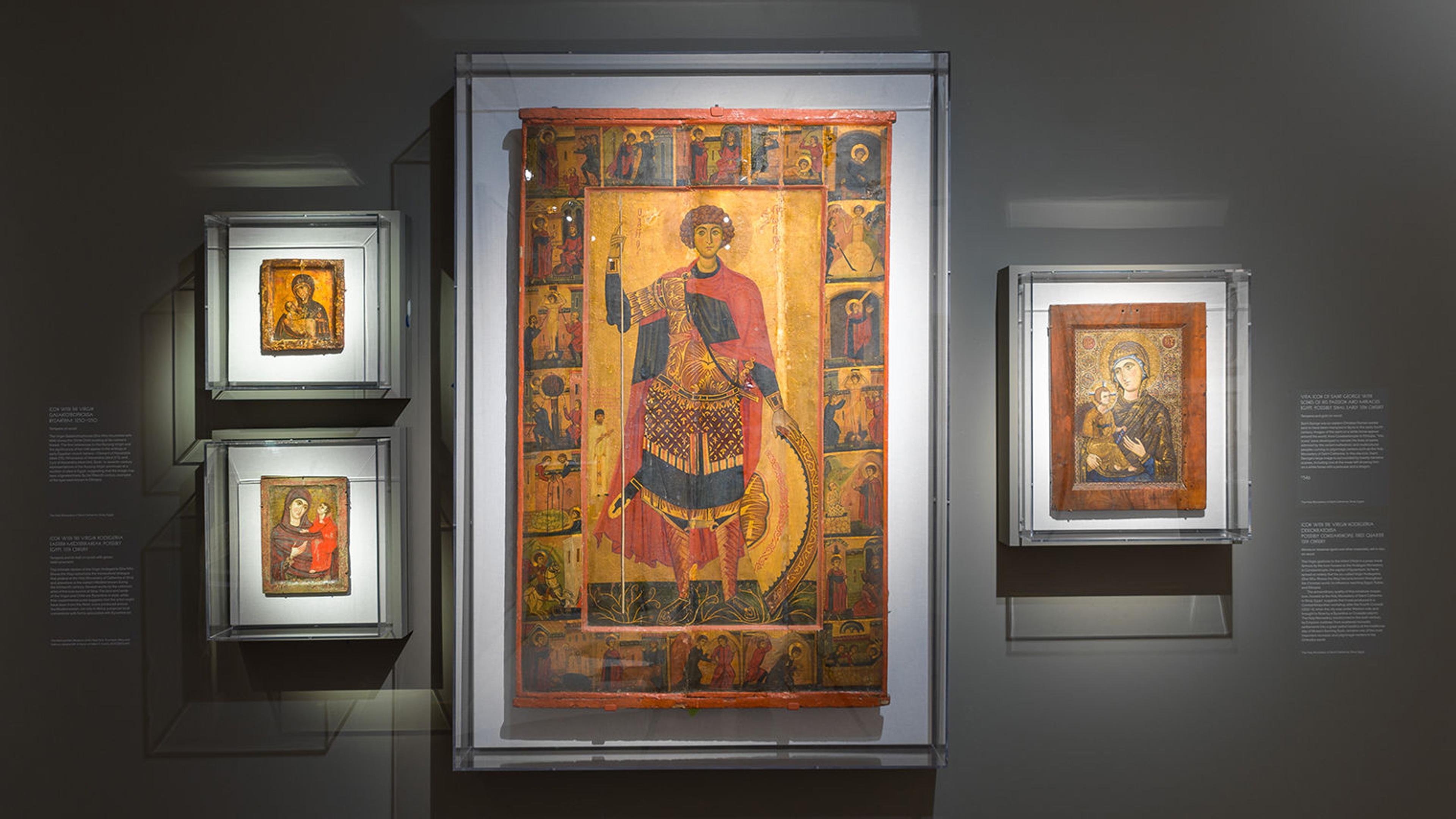
Installation shot from Africa & Byzantium (2023) with the Icon of the Virgin and Child, Hodegetria variant (13th century) in the lower left corner.
In 2020, the Museum acquired a small, intimate thirteenth-century icon of the Virgin and Child painted on a wooden panel as a gift from Mary and Kathryn Jaharis to recognize my time as the curator of Byzantine art. The conserved image displays icons of Orthodox Christian images for contemplation and prayer. Over the centuries, the images depicted on icons have inspired Christians in their devotions and religious art. As The Met increasingly explores cross-cultural connections, some icons, like this Virgin and Child, are significant for their explicit links between Christian communities thought to be very distanced from one another.
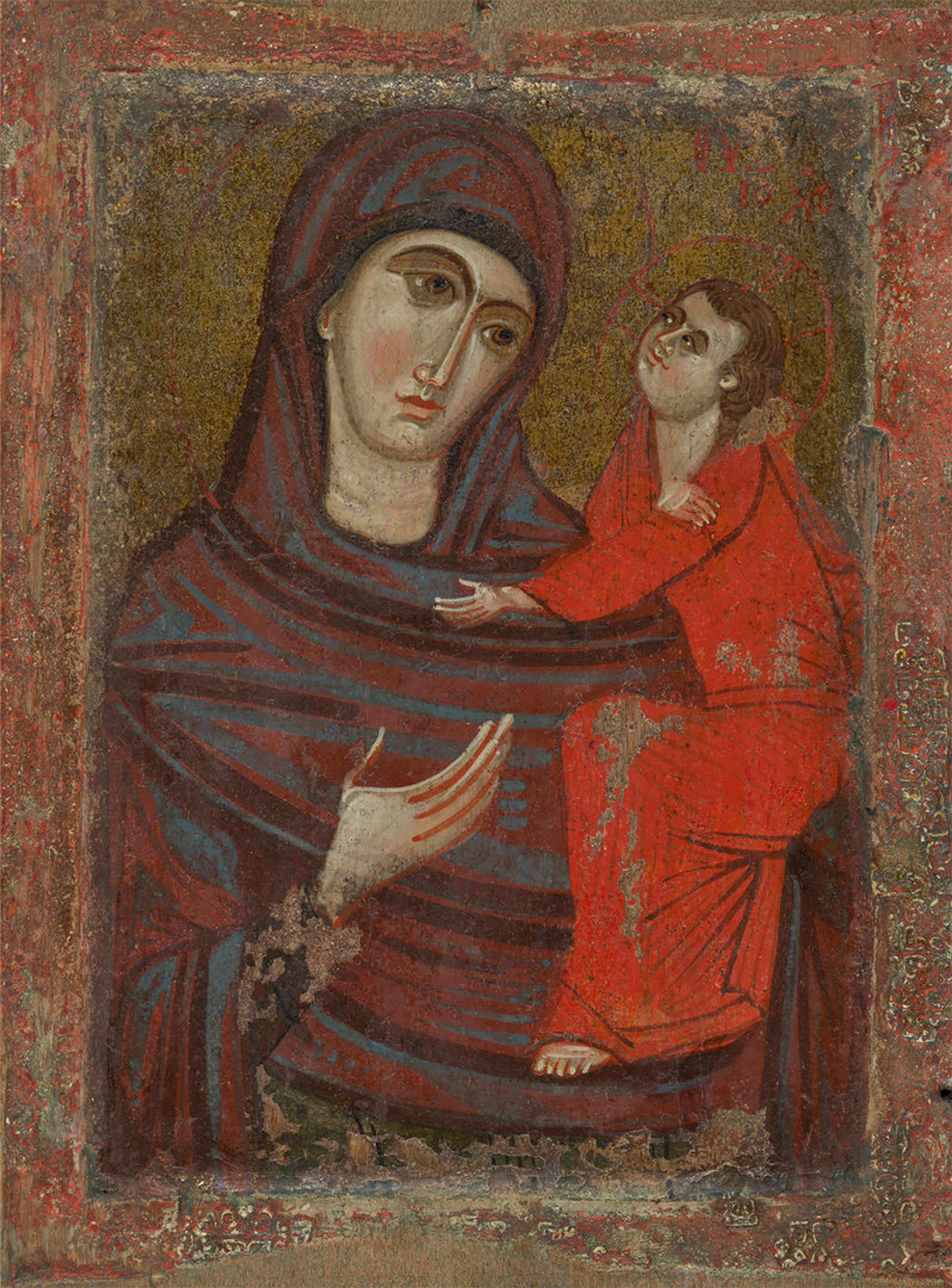
Icon of the Virgin and Child, Hodegetria variant, 13th century. Made in Egypt. Byzantine or Crusader. Tempera on wood, 10 × 7 1/4 × 1/2 in. (25.4 × 18.4 × 1.3 cm). The Metropolitan Museum of Art, New York, Purchase, Mary and Kathryn Jaharis Gift, in honor of Helen C. Evans, 2020 (2020.401)
This image shows an artist exploring how to expand the message of traditional Orthodox Christian icons of the Virgin and Child. The half-length figure of the Virgin holds the Christ Child on her left arm. She gazes toward him with a pensive gaze as she points to him with her elegantly elongated right hand. The Christ Child’s head, with its alert eyes, appears to be thrown back, animating his pose. The golden ground behind the figures emphasizes their otherworldliness. Inscriptions in Greek over the figures identify them as the Theotokos (Mother of God) and Jesus Christ. The icon’s red border would have originally provided an elaborate frame for the figures. The small scale of the image suggests it was created for someone’s personal devotions.
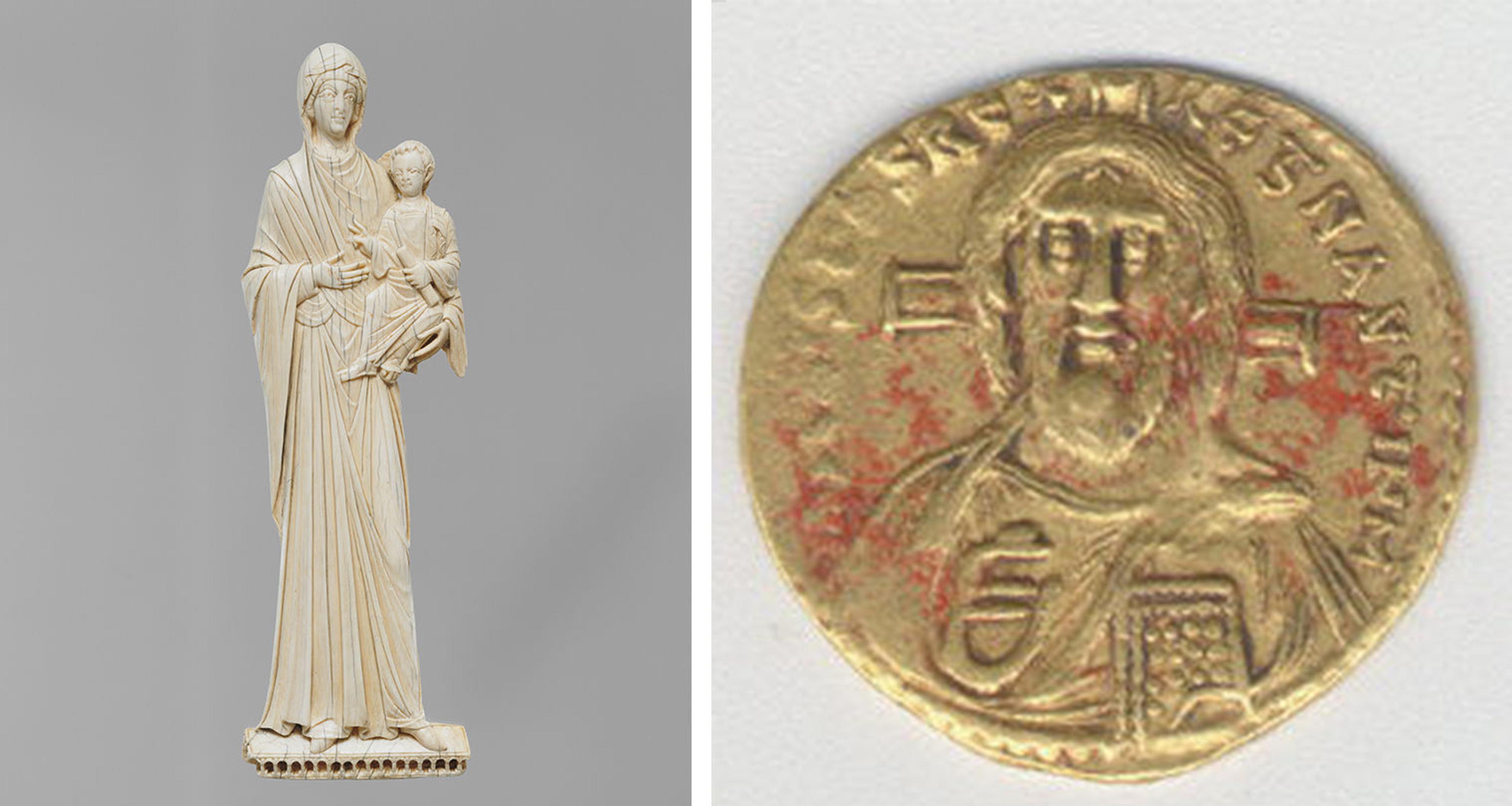
Left: Icon with the Virgin and Child, mid-10th–mid-11th century. Made in probably Constantinople. Byzantine. Ivory, 9 3/16 x 2 3/4 x 1/2in. (23.4 x 7 x 1.3cm). The Metropolitan Museum of Art, New York, Gift of J. Pierpont Morgan, 1917 (17.190.103). Right: Solidus of Justinian II (685-95), 692–695. Made in Constantinople. Byzantine. Gold, 13/16 x 1/16 in. (2 x 0.1 cm).cThe Metropolitan Museum of Art, New York, Gift of Helen Miller Gould, 1910 (10.130.1495)
This image is distinct because it combines elements of two widely known Orthodox icon types that show the artist innovating with the standard iconography. The pose of the Mother and Child is based on the Virgin Hodegetria, she who shows the way, an early icon type seen on a Byzantine ivory icon from the mid-tenth or eleventh century. The Virgin, recognized in the Orthodox world as the Theotokos, shows the way to salvation by pointing to her son. He sits alertly on her left arm, looking out at the viewer. His right hand is in a blessing pose; his left holds his word, the Gospels, as a scroll. Her pensive pose recognizes that he will, as an adult, sacrifice his life for the sins of humankind. His pose echoes images of him as the adult Christ Pantokrator, ruler of all, seen on this Byzantine solidus of the emperor Justinian II (685–95) in The Met’s collection where the scroll has become a Gospel book.
The Christ Child’s pose on The Met’s Jaharis icon differs greatly. The pose borrows from another icon type, the Virgin Eleousa, where the mother and child nestle their heads together, emphasizing his youth and thus humanity. This thirteenth-century micro-mosaic icon shows an example of this type. On the Jaharis icon, the Christ Child’s body remains located where it would be on a Hodegetria icon, but his head is nestled against the Virgin’s neck in a pose like the Eleousa icon.
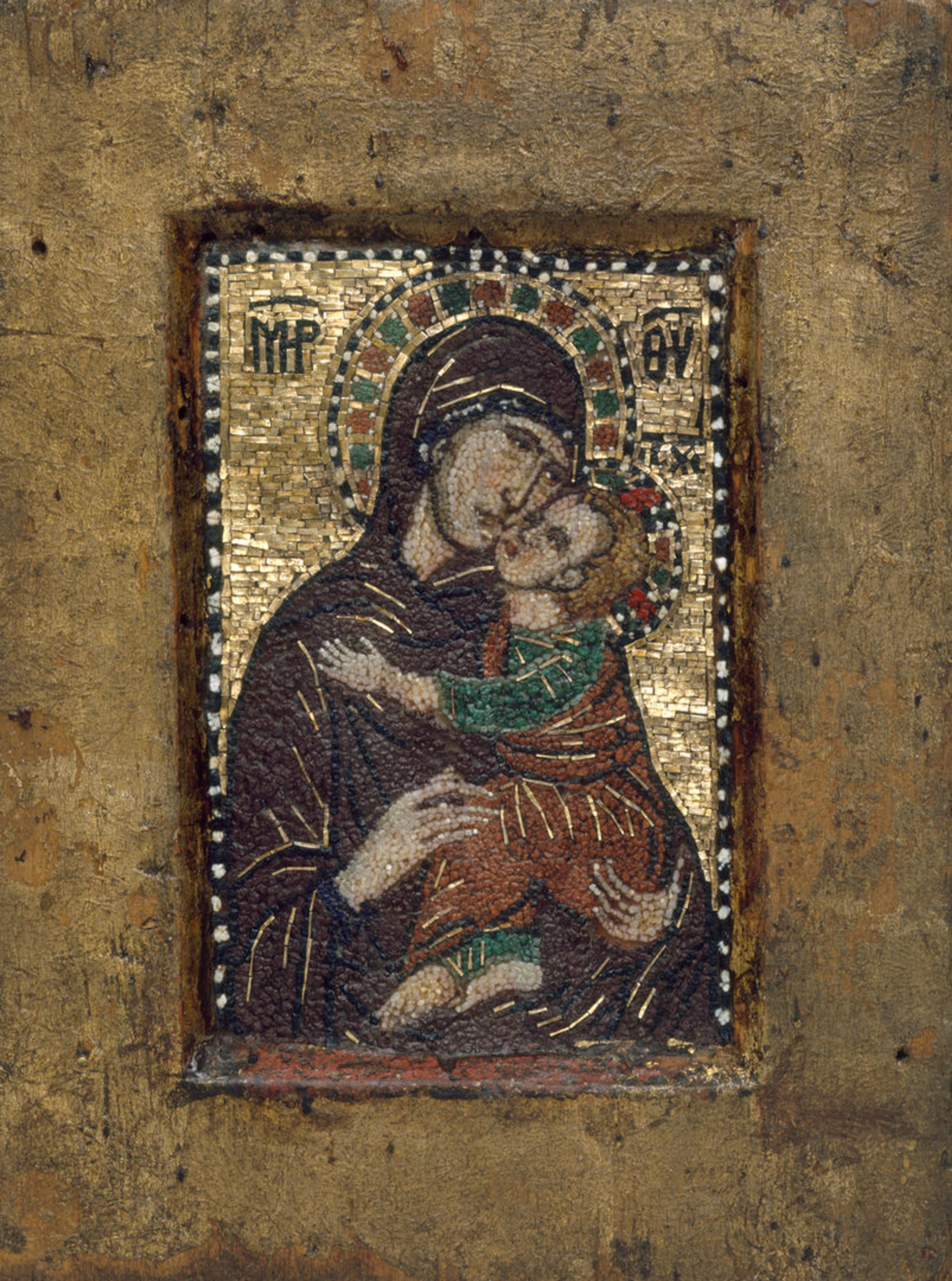
Portable Icon with the Virgin Eleousa, early 1300s. Made in probably Constantinople. Byzantine. Miniature mosaic set in wax on wood panel, with gold, multicolored stones, and gilded copper, 4 7/16 x 3 3/8 x 1/2 in. (11.2 x 8.6 x 1.3 cm). The Metropolitan Museum of Art, New York, Gift of John C. Weber, in honor of Philippe de Montebello, 2008 (2008.352)
Both icons display the Christ Child’s toes, as is standard for Orthodox icons, where they are a reminder that nails will pierce his feet at the Child’s future Crucifixion. On The Met’s Jaharis icon, the Child’s right hand unusually, maybe uniquely, reaches across his chest to grasp his other arm at the shoulder. The micro-mosaic Eleousa icon shows his standard pose with his hand behind the Virgin’s head. Professor Anne Derbes of Hood College has suggested that the unusual hand gesture may emphasize where the cross would rest as the adult Christ carried it to Calvary. If true, the pose indicates the icon was made for a Western audience, like this fifteenth-century icon from Crete painted by Nicolaos Tzafouris. Works painted for Orthodox patrons usually show Simon of Cyrene carrying the Cross for Christ on the way to Calvary.
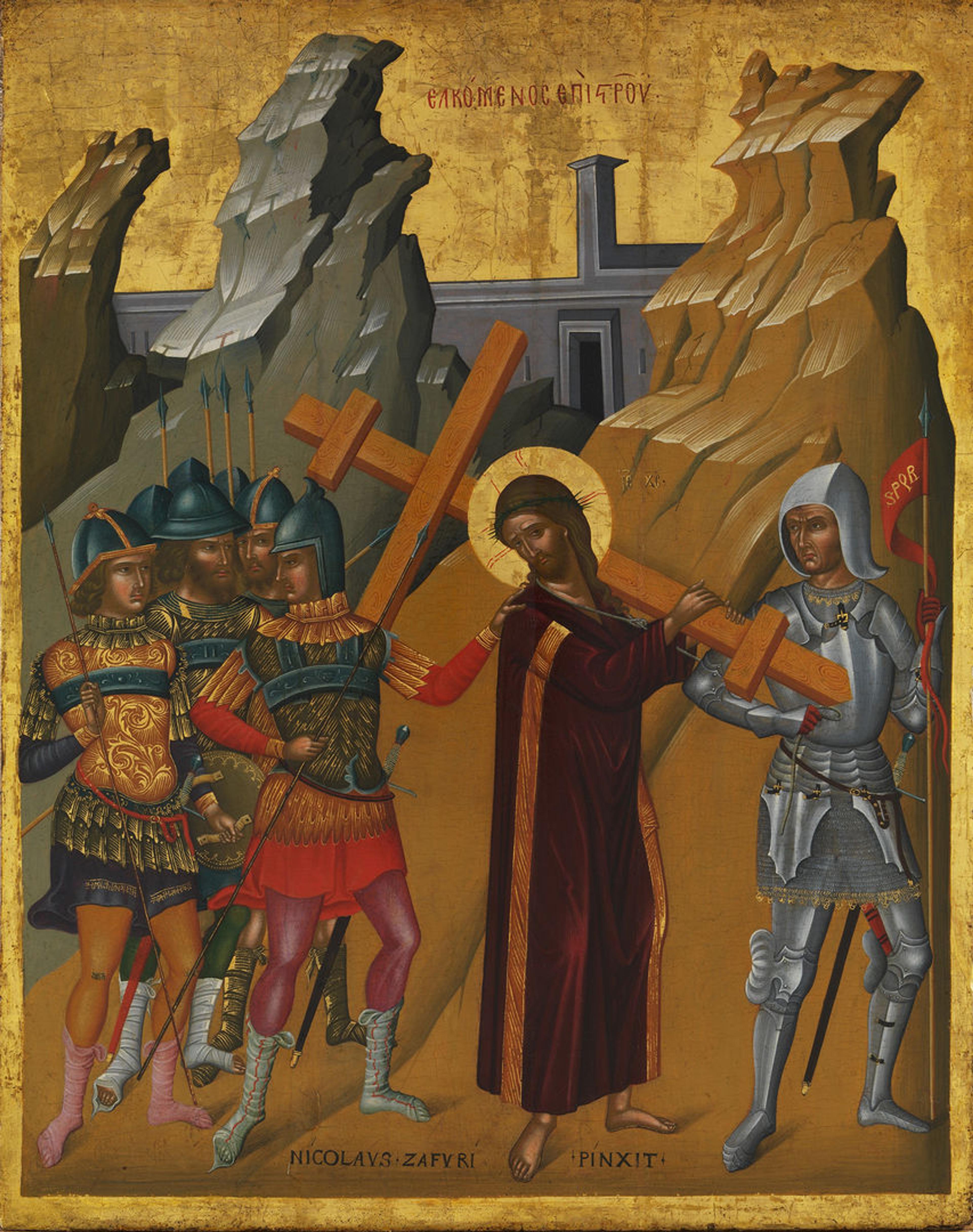
Nicolaos Tzafouris (Greek, ca. 1455–1500/1501). Christ Bearing the Cross, ca. 1455–1500/1501. Oil and tempera on wood, gold ground, 27 1/4 x 21 1/2 in. (69.2 x 54.6 cm). The Metropolitan Museum of Art, New York, Bashford Dean Memorial Collection, Funds from various donors, 1929 (29.158.746)
Why would the artist have made these changes? Who would he have been? Can we be certain for whom he was painting? These were important questions when the icon was brought to us in its original condition by the Fathers of Holy Transfiguration Monastery in Brookline, Massachusetts. The Met has had extensive contact with the Fathers for many years. They brought this work to us because of the respect with which we have installed icons in our galleries.
The Virgin and Child icon came to Holy Transfiguration Monastery with its founding. I wanted to borrow the work for our exhibition The Glory of Byzantium in 1997, so I was delighted to have the opportunity to examine it closely with our painting conservators. The faces and hands of the figures appeared to be in good condition even though the icons showed extensive traces of wear on the lower portions of their garments. The icon’s background was silver, an unexpected color, and the frame, with much of its elaborate gesso patterning lost, was overpainted in a dark green. The back of the icon had an inscription in Cyrillic saying that the Russian hieromonk Savatie (Savvaty) took it from the Monastery of St. Catherine at Sinai in 1914.
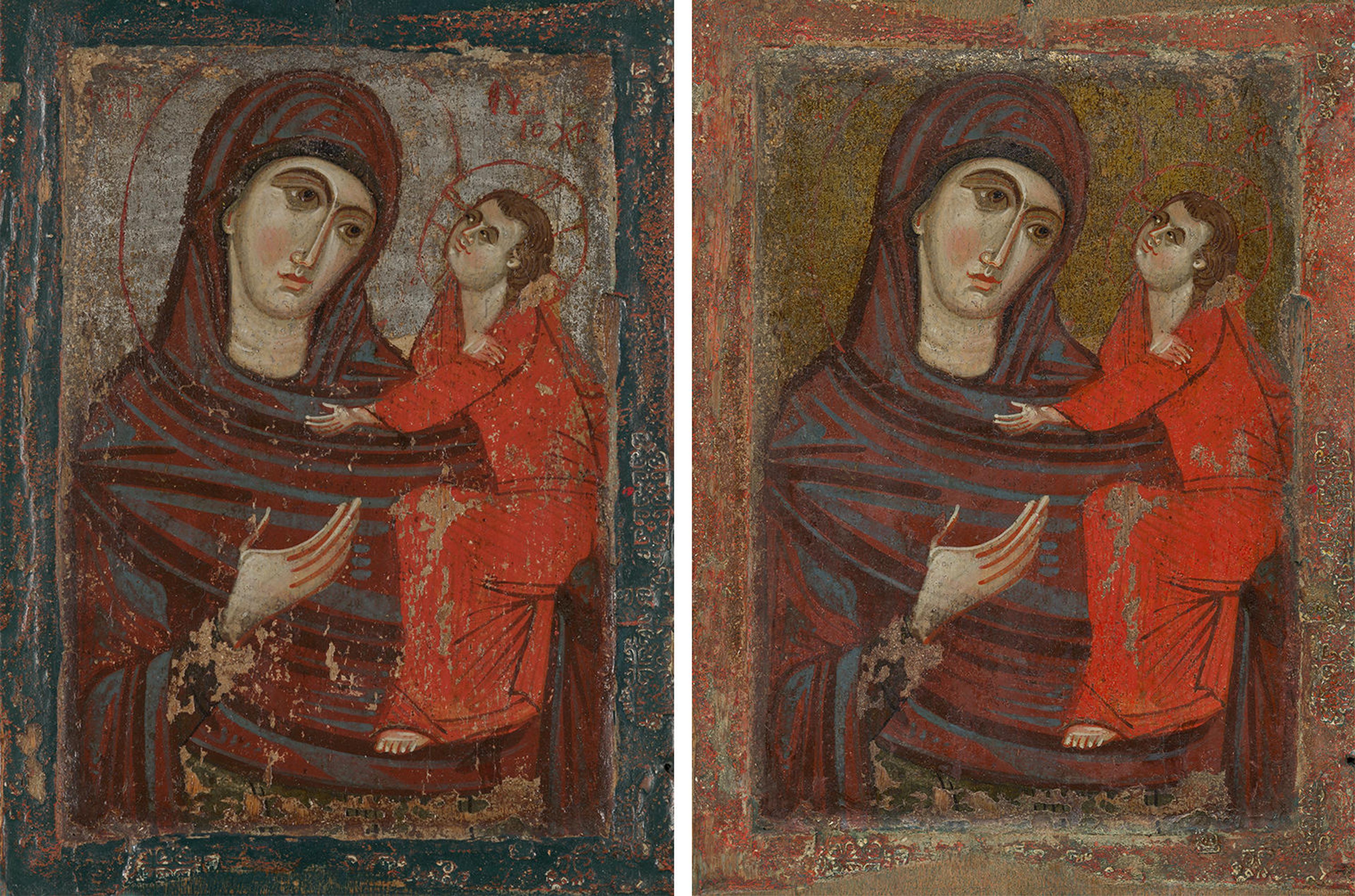
Two images of the Icon of the Virgin and Child, Hodegetria variant (13th century) before conservation on the left and after conservation on the right
Our conservators confirmed through X-rays that the hands and faces of the figures were nearly in their original condition. The silver background of the icon is a layer of tin leaf applied across the upper portion of the wooden ground before the artist painted images over it. The original varnish made the silver ground appear golden but was removed, and the frame was later painted green. We believed that the work could be conserved: our conservators restored the varnish to make the background golden, removed the green paint to reveal the original red paint of the frame, and minimized areas of abrasion on the surface.
For The Met’s 2004 exhibition Byzantium: Faith and Power (1261–1557), we borrowed a number of the Crusader icons from the Holy Monastery of St. Catherine at Sinai. One work seemed to feature the same maker as The Met’s new icon. Both have the same gesso pattern on their frames. The Virgin appears in similar poses and dress in both. Dots of white paint animate the eyes in both images. The head and torso of the Christ Child on both icons have the same pose. The significant difference is in the placement of the figures of the Christ Child. The Virgin and Child’s heads are in the Eleousa pose on the Sinai icon. What is exceptional is that the Christ Child stands on the lower border of the frame, a motif found in Italian art, rather than sitting on the Virgin’s left arm. The Met’s Jaharis image shows the Christ Child in the typical Orthodox pose separated from his Mother but with his head arranged in the Eleousa pose.
Many questions remain about the Jaharis icon. There is much to learn about the thirteenth century when numerous Western Europeans came to the East. In 1204 Constantinople fell to the Crusaders, who ruled there until 1261. Between the First Crusade, which began in 1096 and ended in 1291, Crusade states dominated the eastern Mediterranean coast. Careful study of the artist of this icon and works that can be associated with him should expand our understanding of a moment when various Christian communities were in close communication.
Was the artist a religious figure? Did he work at the Holy Monastery of Saint Catherine at Sinai, which many pilgrims visited, or was the icon brought there from another site associated with the monastery? The monastery had metochions, dependent churches, in many cities, including the capitals of the Crusader States. Was the work done for a Western pilgrim with the unusual motifs added to make the work more relatable to his understanding of his faith? Was the artist an Orthodox icon painter trying to make images more relatable to one of the non-Orthodox patrons now in the East or to introduce new images to his own community? The icon’s faux gold background shows that it was not a work for the elite. For whom was it produced—a monk, a pilgrim? Was it meant to be bought and taken home, or was it a donation to a church or pilgrimage site in the eastern Mediterranean, perhaps even Sinai?
Having the icon at The Met encourages more recognition of the connections between Eastern and Western Christianity. It expands our efforts to understand the world and the artists there, in a more global context.